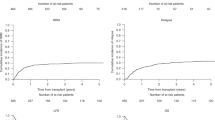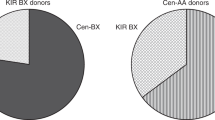Abstract
HLA-DP antigens are beta-alpha heterodimers encoded by polymorphic HLA-DPB1 and -DPA1 alleles, respectively, in strong linkage disequilibrium (LD) with each other. Non-permissive unrelated donor (UD)-recipient HLA-DPB1 mismatches across three different T-cell epitope (TCE) groups are associated with increased mortality after hematopoietic SCT (HCT), but the role of HLA-DPA1 is unclear. We studied 1281 onco-hematologic patients after 10/10 HLA-matched UD-HCT facilitated by the National Marrow Donor Program. Non-permissive mismatches defined solely by HLA-DPB1 TCE groups were associated with significantly higher risks of TRM compared to permissive mismatches (hazard ratio (HR) 1.30, confidence interval (CI) 1.06–1.53; P=0.009) or allele matches. Moreover, non-permissive HLA-DPB1 TCE group mismatches in the graft versus host (GvH) direction significantly decreased the risk of relapse compared to permissive mismatches (HR 0.55, CI 0.37–0.80; P=0.002) or allele matches. Splitting each group into HLA-DPA1*02:01 positive or negative, in frequent LD with HLA-DPB1 alleles from two of the three TCE groups, or into HLA-DPA1 matched or mismatched, did not significantly alter the observed risk associations. Our findings suggest that the effects of clinically non-permissive HLA-DPB1 TCE group mismatches are independent of HLA-DPA1, and that selection of donors with non-permissive DPB1 TCE mismatches in GvH direction might provide some protection from disease recurrence.
This is a preview of subscription content, access via your institution
Access options
Subscribe to this journal
Receive 12 print issues and online access
$259.00 per year
only $21.58 per issue
Buy this article
- Purchase on Springer Link
- Instant access to full article PDF
Prices may be subject to local taxes which are calculated during checkout



Similar content being viewed by others
References
Hollenbach JA, Madbouly A, Gragert L, Vierra-Green C, Flesch S, Spellman S et al. A combined DPA1-DPB1 amino acid epitope is the primary unit of selection on the HLA-DP heterodimer. Immunogenetics 2012; 64: 559–569.
Rutten CE, van Luxemburg-Heijs SA, Griffioen M, Marijt EW, Jedema I, Heemskerk MH et al. HLA-DP as specific target for cellular immunotherapy in HLA class II-expressing B-cell leukemia. Leukemia 2008; 22: 1387–1394.
Rutten CE, van Luxemburg-Heijs SA, Halkes CJ, Halkes CJ, van Bergen CA, Marijt EW et al. Patient HLA-DP-specific CD4+ T cells from HLA-DPB1-mismatched donor lymphocyte infusion can induce graft-versus-leukemia reactivity in the presence or absence of graft-versus-host disease. Biol Blood Marrow Transplant 2013; 19: 40–48.
Shaw BE, Gooley TA, Malkki M, Madrigal JA, Begovich AB, Horowitz MM et al. The importance of HLA-DPB1 in unrelated donor hematopoietic cell transplantation.Blood 2007; 110: 4560–4566.
Stevanovic S, van Bergen CA, van Luxemburg-Heijs SA, van der Zouwen B, Jordanova ES, Kruisselbrink AB et al. HLA-class II upregulation during viral infection leads to HLA-DP directed graft-versus-host disease after CD4+ donor lymphocyte infusion. Blood 2013; 122: 1963–1973.
Fleischhauer K, Shaw BE, Gooley T, Malkki M, Bardy P, Bignon JD et al. Effect of T-cell-epitope matching at HLA-DPB1 in recipients of unrelated donor haemopoietic-cell transplantation: a retrospective study. Lancet Oncol 2012; 13: 366–374.
Zino E, Frumento G, Marktel S, Sormani MP, Ficara F, Di Terlizzi S et al. A T cell epitope encoded by a subset of HLA-DPB1 alleles determines non-permissive mismatches for hematological stem cell transplantation. Blood 2004; 103: 1417–1424.
Crocchiolo R, Zino E, Vago L, Oneto R, Bruno B, Pollichieni S et al. Non-permissive HLA-DPB1 disparity is a significant independent risk factor for mortality after unrelated hematopoietic stem cell transplantation. Blood 2009; 114: 1437–1444.
Shaw BE, Robinson J, Fleischhauer K, Madrigal JA, Marsh SG . Translating the HLA-DPB1 T-cell epitope-matching algorithm into clinical practice. Bone Marrow Transplant 2013; 48: 1510–1512.
Farag SS, Bacigalupo A, Eapen M, Hurley C, Dupont B, Caligiuri MA et al. The effect of KIR ligand incompatibility on the outcome of unrelated donor transplantation: a report from the Center for International Blood and Marrow Transplant Research, the European Blood and Marrow Transplant Registry, and the Dutch Registry. Biol Blood Marrow Transplant 2006; 12: 876–884.
Spellman S, Setterholm M, Maiers M, Noreen H, Oudshoorn M, Fernandez-Viña M et al. Advances in the selection of HLA-compatible donors: refinements in HLA typing and matching over the first 20 years of the National Marrow Donor Program Registry. Biol Blood Marrow Transplant 2008; 14: 37–44.
Lauterbach N, Crivello P, Wieten L, Zito L, Groeneweg M, Voorter CE et al. Allorecognition of HLA-DP by CD4+ T cells is affected by polymorphism in its alpha chain. Mol Immunol 2014; 59: 19–29.
Varney MD, Lester S, McCluskey J, Gao X, Tait BD . Matching for HLA DPA1 and DPB1 alleles in unrelated bone marrow transplantation. Hum Immunol 1999; 60: 532–538.
Sasazuki T, Juji T, Morishima Y, Kinukawa N, Kashiwabara H, Inoko H et al. Effect of matching of class I HLA alleles on clinical outcome after transplantation of hematopoietic stem cells from an unrelated donor. Japan Marrow Donor Program. N Engl J Med 1998; 339: 1177–1185.
Petersdorf EW, Kollman C, Hurley CK . Effect of HLA class II gene disparity on clinical outcome in unrelated donor hematopoietic cell transplantation for chronic myeloid leukemia: the US National Marrow Donor Program Experience. Blood 2001; 98: 2922–2929.
Lee SJ, Klein J, Haagenson M, Baxter-Lowe LA, Confer DL, Eapen M et al. High-resolution donor-recipient HLA matching contributes to the success of unrelated donor marrow transplantation. Blood 2007; 110: 4576–4583.
Schaffer M, Aldener-Cannavá A, Remberger M, Ringdén O, Olerup O . Roles of HLA-B, HLA-C and HLA-DPA1 incompatibilities in the outcome of unrelated stem-cell transplantation. Tissue Antigens 2003; 62: 243–250.
Fernández-Viña MA, Klein JP, Haagenson M, Spellman SR, Anasetti C, Noreen H et al. Multiple mismatches at the low expression HLA loci DP, DQ, and DRB3/4/5 associate with adverse outcomes in hematopoietic stem cell transplantation. Blood 2013; 121: 4603–4610.
Acknowledgements
This work was supported by a grant (no. IG12042) from the Associazione Italiana per la Ricerca sul Cancro (AIRC) to KF. The CIBMTR is supported by Public Health Service Grant/Cooperative Agreement U24-CA76518 from the National Cancer Institute (NCI), the National Heart, Lung and Blood Institute (NHLBI) and the National Institute of Allergy and Infectious Diseases (NIAID); a Grant/Cooperative Agreement 5U01HL069294 from NHLBI and NCI; a contract HHSH234200637015C with Health Resources and Services Administration (HRSA/DHHS); two grants, N00014-12-1-0142 and N00014-13-1-0039, from the Office of Naval Research; grants from Allos, Inc., Amgen, Inc., Angioblast; anonymous donation to the Medical College of Wisconsin; Ariad; Be the Match Foundation; Blue Cross and Blue Shield Association; Buchanan Family Foundation; CaridianBCT; Celgene Corporation; CellGenix, GmbH; Children’s Leukemia Research Association; Fresenius-Biotech North America, Inc.; Gamida Cell Teva Joint Venture Ltd.; Genentech, Inc.; Genzyme Corporation; GlaxoSmithKline; HistoGenetics, Inc.; Kiadis Pharma; The Leukemia & Lymphoma Society; The Medical College of Wisconsin; Merck & Co, Inc.; Millennium: The Takeda Oncology Co.; Milliman USA, Inc.; Miltenyi Biotec, Inc.; National Marrow Donor Program; Optum Healthcare Solutions, Inc.; Osiris Therapeutics, Inc.; Otsuka America Pharmaceutical, Inc.; RemedyMD; Sanofi; Seattle Genetics; Sigma-Tau Pharmaceuticals; Soligenix, Inc.; StemCyte, A Global Cord Blood Therapeutics Co.; Stemsoft Software, Inc.; Swedish Orphan Biovitrum; Tarix Pharmaceuticals; Teva Neuroscience, Inc.; THERAKOS, Inc.; and Wellpoint, Inc.
Author information
Authors and Affiliations
Corresponding author
Ethics declarations
Competing interests
The authors declare no conflict of interest
Additional information
Supplementary Information accompanies this paper on Bone Marrow Transplantation website
Supplementary information
Rights and permissions
About this article
Cite this article
Fleischhauer, K., Fernandez-Viña, M., Wang, T. et al. Risk associations between HLA-DPB1 T-cell epitope matching and outcome of unrelated hematopoietic cell transplantation are independent of HLA-DPA1. Bone Marrow Transplant 49, 1176–1183 (2014). https://doi.org/10.1038/bmt.2014.122
Received:
Revised:
Accepted:
Published:
Issue Date:
DOI: https://doi.org/10.1038/bmt.2014.122
This article is cited by
-
HLA-DPB1 mismatch induces a graft-versus-leukemia effect without severe acute GVHD after single-unit umbilical cord blood transplantation
Leukemia (2018)
-
Directionality of non-permissive HLA-DPB1 T-cell epitope group mismatches does not improve clinical risk stratification in 8/8 matched unrelated donor hematopoietic cell transplantation
Bone Marrow Transplantation (2017)
-
Analysis of allogeneic hematopoietic stem cell transplantation with high-dose cyclophosphamide-induced immune tolerance for severe aplastic anemia
International Journal of Hematology (2016)



